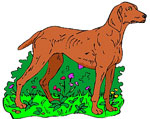

 Large dogs tend to grow rapidly but mature slowly. Their quick growth
means they are prone to bone problems, so it's imperative that you
feed the young dog well and try to prevent him from running and
jumping about too much, which is easier said than done!
Large dogs tend to grow rapidly but mature slowly. Their quick growth
means they are prone to bone problems, so it's imperative that you
feed the young dog well and try to prevent him from running and
jumping about too much, which is easier said than done!
Many of the larger breeds have relaxed, mellow temperaments, despite their perceived personalities, which often stem from Hollywood and the media rather than the dogs themselves. However, they cost considerably more to feed than the smaller breeds, often require specialist diets to keep their weight under control and their joints strong, and will need larger (and therefore more expensive) beds and collars, and more robust toys to keep them amused. If the worst happens and your dog needs an operation, bear in mind that vets charge for anaesthetics and drugs by volume, which is determined by the dog's weight.
Sadly, the larger the dog, the shorter the lifespan. Many large dogs only live for six to 10 years - but at least those years will be spent with a fun and loving companion.
Large breeds include the Afghan Hound, Anatolian Shepherd Dog, Bernese Mountain Dog, Bloodhound, Borzoi, Cane Corso, Giant Schnauzer, Great Pyrenees, Greater Swiss Mountain Dog, Hungarian Kuvasz, Irish Wolfhound, Komondor, Leonberger, Newfoundland, Scottish Deerhound, St Bernard, and Molossers, which is a group comprising of several breeds, many of which are Mastiffs. Molossers include the Bullmastiff, Dogue de Bordeaux, English Mastiff, Fila Brasileiro, Spanish Mastiff, Neapolitan Mastiff and Tibetan Mastiff.
If you choose a complete food that is formulated to give the puppy everything he needs to grow well, then you can't go wrong. The pup will need to change to a formulation for junior or young dogs at about six months of age. Unlike smaller breeds, who could move on to an adult mix from a year old, the larger dogs will need to stay on a junior feed until then are anything up to 18 months old. Your vet or breeder will be able to advise you.
As for an adult diet, there are several foods available now which have been developed with the larger breed in mind, particularly in relation to energy requirements, and with a larger kibble size which helps prevent a larger dog bolting its food too quickly.
Because they grow so quickly, large breeds are prone to joint problems such as hip and elbow dysplasia, and arthritis. They are also at risk of osteosarcoma, which is a malignant type of bone cancer, often affecting the Irish Wolfhound, German Shepherd, Greyhound and Rottweiler - and St Bernards, in which the disease may be hereditary. Hypertrophic osteodystrophy (HOD) is another bone disease that affects large dogs, and usually occurs between two and seven months of age. Basically, because the blood doesn't flow properly to the bone, it stops the skeleton from developing. Symptoms include pain, depression, lameness, fever, and deformity of the joints. Always get limb problems in large breeds seen by a vet.
Cardiomyopathy, which is inflammation and scarring of the heart, is the bane of many large breeds, and is most prevalent among Dobermanns. First symptoms of this fatal condition include coughing so, again, don't overlook this sign. Proper care, a healthy diet and a loving environment can significantly lengthen the lifespan of a large breed.
Despite their appearance and often unjust media portrayal, large dogs tend to be affectionate, relaxed and gentle. They are loyal dogs who will protect you and yet can make excellent companions for children. It is no coincidence that larger breeds are used as helpers and rescue dogs - their courage and ruggedness, combined with a trainable temperament, make them ideal for the job. Like all dogs, large breeds can show aggression to strangers. However, they are the most loyal of animals, and will put up with an amazing amount of 'abuse' from children - as long as they are part of the family and, therefore, part of his pack.
The amount of time that needs to be devoted to keeping your large breed clean, comfortable and healthy will depend largely on his type.
Shorter-haired breeds such as the Anatolian Shepherd Dog, Cane Corso, Fila Brasileiro and many Mastiffs will need far less combing than the Afghan Hound, Komondor or Leonberger, which resemble walking wigs or mops. When you also consider that many of these breeds love water and all things dirty, you may spend quite some time grooming! But your happy, gleaming dog will more than make up for the trouble.
Large dogs need to have plenty of space to stretch their considerable legs, but they probably don't need as much exercise as you imagine. Don't over-exert young dogs, as this can cause joint problems.
It takes firm yet patient handling to ensure your
pup turns in to a trusted and obedient companion.
Many of these large breeds are natural protectors, who will alert
you to a possible intruder and can even show disdain or dislike
towards strangers. However, as long as your dog is well trained,
he will be trustworthy, and the sheer existence of a large dog will
make you and your home less likely to be attacked.
(source PPM magazine)